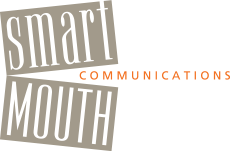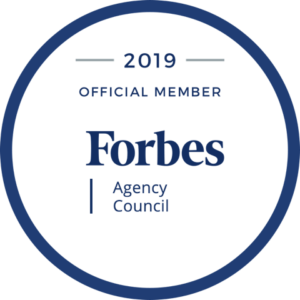by Beth Levine | Feb 22, 2011 | Just Mouthing Off
So, let me guess what you’ve been doing when you prepare to speak: You crack open your laptop, create a new Word document, and you begin writing a magnum opus. You choose every word carefully, spending quite a bit of time creating pages of brilliant, gorgeous prose that will become your talk. Am I close? Probably. Is there a problem with that? Typically, yes.
All too often, what writes and reads as perfection to your eyes isn’t equally speakable as perfection for your mouth. All too often, well-written talks will sound like what they are … essays. And all too often, you, the speaker, will find yourself so committed to your beautiful words, sentences and paragraphs that you either 1) read from the paper, eyes down, and lose connection with your audience; or 2) you try to balance reading with audience connection and you end up flustered because you lose your place or leave something out when you look up.
What to do then when you prepare to speak? Crack open that laptop, but talk while you type. Test yourself by reading out loud what you wrote to make sure the sentences are deliverable versus just readable. Hint: if they’re deliverable, they’re usually short and crisp, without a lot of clauses and punctuation. Try bullet points, and trust yourself to fill in around those well-chosen points while you’re speaking.
However, if you are someone who absolutely has to have a full-text speech in front of them, then make sure you give yourself a hall pass if you end up deviating from your beautiful script; you are unlikely to deliver exactly what you wrote. Even folks with bullet points deviate. Deviating is okay, because it’s usually a sign that you are staying present with your audience. And the audience is, after all, what it’s all about!
by Beth Levine | Feb 16, 2011 | Just Mouthing Off
The best way to navigate around a tricky audience or tricky situation is to ask questions. For example …
Feeling awkward in one of those networking meetings or events? Ask questions.
Looking to fill the awkward silence on the elevator with the big boss? Ask questions.
Not sure who’s in charge of the meeting and what the expectations are? Ask questions.
Delivering a talk and not sure you’re connecting with the group? Ask questions.
Suffering with incredible nervousness at the start of a speech? Ask questions.
If it’s an audience of one or one hundred, you can and should ask questions. The larger the group, the more daunting it seems, but it’s actually not daunting at all. It’s doable and it’s really quite endearing to an audience. Try it!
by Beth Levine | Feb 7, 2011 | Just Mouthing Off
Audiences typically pay attention to and retain what a speaker says at the beginning and at the end of a talk. If you do it right, you have them at hello! The opening and closing count for a lot, so work it …
In the opening, you have the opportunity to condition or prepare your audience for what’s coming; you have a chance to grab their attention and set a filter in their brains for what you will be covering and how you hope they’ll receive it. Use that opportunity. Tell them exactly what you want them to pay attention to and why.
In the closing, you have a chance to reinforce, leave a lasting (positive!) impression, and even offer up a call to action. The closing is arguably even more memorable than the opening simply because it’s at the end. Don’t squander that chance either … and don’t, whatever you do, ask “Any questions?” for your closing (see last week’s blog post!).
The middle – the body of your talk, probably where the meat is – is where your audiences drift, space out, lose focus, check their mental to-do lists. Sad and kind of ironic, because that’s where your topic is covered, the very topic you were invited to address!
You will have them at hello and be more likely to hold their attention in the middle if you give some thought to bookending your talk with a powerful, here-it-is-in-a-nutshell opening and a nice clean finish of a closing that sums it all up so your audience doesn’t have to do all that mental work on their own.
So, here’s my advice … if you have no time to prepare, use your few seconds or minutes to decide how you’re going to open and close, and then wing the middle (ugh, did I just say that?)!
by Beth Levine | Jan 31, 2011 | Just Mouthing Off
Standard operating procedure is not usually standout. Especially when it comes to speaking or presenting. Take, for instance, the age-old closer: “Any questions?” Let’s be honest, “Any questions?” is quite simply the international “I’m-done-here-and-I-want-to-appear-to-be-open-to-it-but-please-don’t-ask-me-anything” signal.
Business people who have been through my training have had “Any questions?” purged from their repertoires. Not allowed. Why? Simple: It’s way too vague and open-ended, and it’s all too often insincere. A speaker will typically say it at the tail end of a meeting or presentation when everyone is ready to go. And so in any given audience there are people who are too intimidated to ask a question; they recognize the speaker is done, time has run out, and anyway they have 50 questions, not just one. A lot of audience members are thinking, “sheesh, where would I even begin?” And so they leave the room not entirely sure of what they are supposed to think or know or do. Another presentation is lost.
What, you ask, should replace “Any questions?”? Well, first off, it’s nice to reach into your audience (even, and especially, when it’s small) to ask for reflection back. As in, “tell me what you heard/remembered from my talk today?” Or, “is there anything about what I just covered that still leaves you puzzled?” And even better, “what else can I tell you or provide you with that will help complete your understanding?” These questions will give you incredible real-time feedback about how effective you were at getting your point(s) across.
And perhaps more importantly, these questions do not need to be saved until the very end. They can and should be sprinkled throughout a talk, especially when audience comprehension is critical … e.g. with clients! If you have to save questions for the very end, then please make every effort to leave ample time.
“Any questions?” is so very superficial, I fear it has become a throwaway line. Be better than that, connect, dig deeper, get real and get open about it. Ask something meatier and more specific.
So, with that, I won’t ask “Any questions?” Instead, I’ll ask if you would now feel comfortable switching it up and trying out something new, something more specific, the next time you speak to a group? And if not, how can I help you with that … ?
by Beth Levine | Jan 25, 2011 | Just Mouthing Off
I am not a football fan, but I love the weeks leading up to the Super Bowl. These weeks are rich with athletes talking on-camera about winning, losing, how they feel, what they were thinking, predictions for the future, etc. Their performances on-camera vary wildly … for me, it’s more fun to watch the interviews than the games!
Here’s what so often perplexes me, though. (Listen up, you office types, this applies to you too!) All too often the athletes seem unprepared for the questions. Really? You weren’t expecting that? I’m scratching my head … there are only two potential outcomes to an athletic competition, winning and not winning. And there’s a set of pretty predictable questions. Surely, an athlete can mentally prepare for at least minute to get his head around how he’d like to frame up each of those situations.
This is really true for most of us who are called upon to speak … maybe not into a TV camera, but certainly in meetings and in other typical venues. We act like we weren’t expecting to have to speak. Really? Why aren’t we always at-the-ready? Are we working on that project, are we responsible for that client, are we a member of the staff that is having the staff meeting? Well then, we need to buck up … and spend a minute or two getting our heads around what we’d like everyone to know and remember about our work.
On the field or in the office, I say plan for and play good offense … playing defense is a lot harder!



